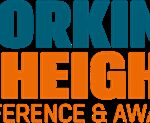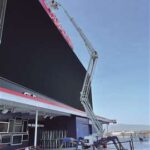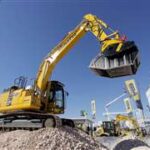Here’s What You Need to Know
Choosing the right scissor lift for your job might seem like a big decision, but we’re here to break it down and make it simple! Whether you’re tackling indoor maintenance or heading outdoors for some heavy-duty work, there’s a scissor lift that fits your needs perfectly. Let’s take a closer look at the two main types: slab scissor lifts and rough terrain scissor lifts.
What is a Slab Scissor Lift?
Slab scissor lifts are your go-to for indoor jobs where you need to get up high, but don’t need to worry about tough, outdoor terrain. These lifts are designed for smooth, flat surfaces, which makes them perfect for jobs like ceiling repairs, sign installations, and warehouse management. With their compact design, slab scissor lifts can easily maneuver through narrow doorways and tight corners, making them super versatile for indoor tasks.
These lifts are powered by electric motors, which means they run quietly and don’t produce emissions—perfect for environments where noise is an issue or where air quality matters (like hospitals or schools). But while they’re great for indoor use, slab scissor lifts do have some limitations. For example, their lifting capacity isn’t as high as that of rough terrain models, and they don’t handle rough ground very well. If your job requires more than light-duty lifting, or if you’re working outdoors, a rough terrain lift might be a better choice.
What About Rough Terrain Scissor Lifts?
Now, if you’re heading outside for a project that involves uneven ground, rough terrain scissor lifts are the way to go. These lifts come equipped with large pneumatic tires and four-wheel drive, so they can handle all kinds of rough surfaces, from gravel to mud. This makes them perfect for construction sites, outdoor landscaping, and even working on uneven roads.
Rough terrain lifts are powered by diesel engines, which give them the power they need to tackle tough jobs. They also have a higher lifting capacity and larger platforms, which makes them great for tasks that need to carry heavy loads or more workers. Whether you’re lifting materials for a construction project or doing maintenance on a large piece of equipment, a rough terrain lift can handle it all.
When to Choose Slab vs. Rough Terrain Lifts?
So, when should you choose a slab scissor lift, and when should you go for a rough terrain lift? Here’s a quick guide:
- Slab Scissor Lifts: Best for indoor jobs on smooth surfaces (think warehouses, facilities, schools). They’re great for smaller spaces, and their electric-powered motors mean you don’t have to worry about emissions or noise.
- Rough Terrain Scissor Lifts: Ideal for outdoor work on uneven ground (think construction, landscaping, or maintenance tasks in the great outdoors). They’re more powerful, have higher lifting capacities, and are built to last through tougher conditions.
Maintenance Differences
Another key difference between the two types of lifts is maintenance. Slab scissor lifts generally have fewer moving parts, making them easier and cheaper to maintain. All you need to worry about is keeping the battery charged and checking basic components.
On the flip side, rough terrain lifts require a bit more attention. Since they’re used in tough environments, you’ll need to regularly check the diesel engine, tires, and hydraulic systems. But don’t worry—if you keep up with maintenance, your rough terrain lift will keep running smoothly for years.
Which One Should You Choose?
The decision ultimately depends on the job you’re doing. If you’re indoors and need a quiet, efficient lift for light tasks, go with a slab scissor lift. But if you’re dealing with the great outdoors or need a lift that can handle heavy lifting, a rough terrain scissor lift is your best bet.




